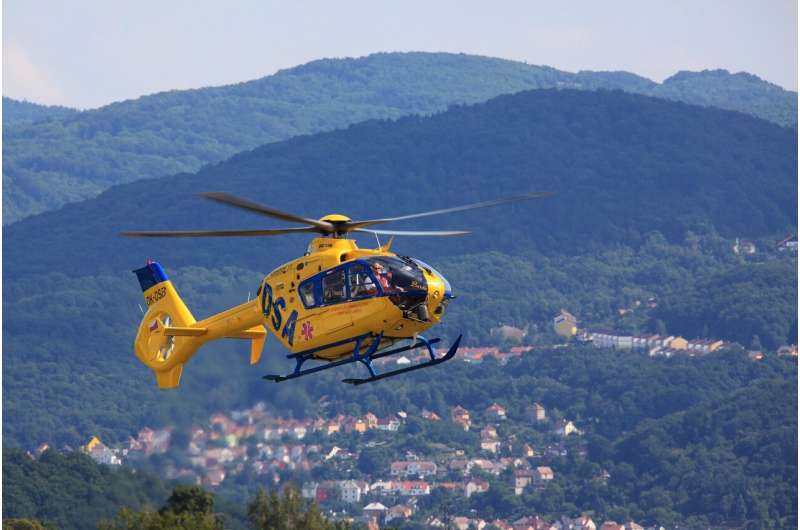This article has been reviewed according to Science X's editorial process and policies. Editors have highlighted the following attributes while ensuring the content's credibility:
fact-checked
peer-reviewed publication
trusted source
proofread
Helicopter transport of trauma patients associated with improved survival after severe injury

Severely injured patients who meet criteria for care at a trauma center have nearly double the odds of surviving if they are transported directly by medical helicopter to a Level I or II trauma center, compared to those first driven to a regular hospital and then flown to a trauma center, according to a new analysis led by University of Pittsburgh School of Medicine and UPMC physician-scientists.
The research, published today in the Annals of Surgery, can help guide immediate decisions on care for critically injured patients, as well as longer term allocation of emergency services and geographic location of trauma centers, particularly in rural areas.
"We've long suspected that these 'pit stops' at the local hospital were hurting more than helping patients who we knew needed to be at a trauma center," said senior author Joshua Brown, M.D., assistant professor of surgery and critical care medicine at Pitt and a UPMC trauma surgeon. "But nobody had ever put numbers to it until now. Our research provides evidence to identify who these patients are and properly balance emergency resources in rural America to best save lives."
Brown and his colleagues analyzed data on 36,830 patients age 16 and older who were included in the Pennsylvania Trauma Outcomes Study registry. The patients all had a traumatic injury that met National Field Triage Guidelines and were transported by ground or air from the scene between Jan. 1, 2000, and Sept. 27, 2017. Patients were excluded if burn was the primary injury.
Of these patients, 74% were transported directly by medical helicopter to a trauma center, while the rest were first taken by ambulance to a nearby hospital that didn't have a level I or II trauma certification before being transferred to a hospital with the higher-level designation. Level I/II trauma centers have equipment and specialists on hand at all hours to immediately treat a wide range of complex injuries.
In addition to finding a nearly two-fold increase in odds of survival for patients transported directly by medical helicopter to a Level I or II trauma center, the study team determined that the result was even more pronounced the longer the transport distances. In other words, patients located more than 70 miles from the nearest hospital saw even greater benefit if they were flown directly to a trauma center as opposed to those who were first driven to that hospital and then transferred. The team also found a set of criteria that first responders can use to identify patients who benefit most from being flown directly to a trauma center.
"One may think that getting the patient to the closest hospital could help with stabilizing them before transfer to a higher level of care, but we found that wasn't the case," said Brown, who started his medical career as an emergency services technician. "In fact, mortality risk increased with every minute that the medical helicopter crew was waiting at the local hospital for the patient to be released to them—so, time spent at a non-trauma hospital only delays necessary trauma care and appears to do more harm than good."
However, he said, the solution isn't necessarily to dramatically increase the number of medical helicopters and crews.
"The knee-jerk reaction may be to have medical helicopters available everywhere at all times," Brown said. "That would not only be cost prohibitive, but also detrimental to receiving advanced care. The reason helicopter crews are as good as they are is because they see a lot of patients and get a lot of experience. Diluting that experience with a glut of rarely used medical helicopters and crews would be counterproductive."
A better approach, Brown said, would be for state and federal officials to support a geographical distribution of trauma centers that minimizes medical helicopter transport distance while still pulling in enough patients to keep the centers active. In addition, emergency medical services training should emphasize the evidence supporting immediate helicopter transport to high-level care.
"As we've seen a trend toward consolidation creating more distance between local hospitals, especially in rural America, it is important for all emergency medical services crews to know that if they have a patient who meets these trauma criteria, they should call for the helicopter," Brown said. "Don't agonize about something that so clearly means the difference between life and death."
More information: Andrew-Paul Deeb et al, Direct Trauma Center Access by Helicopter Emergency Medical Services is Associated with Improved Survival after Severe Injury, Annals of Surgery (2023). DOI: 10.1097/SLA.0000000000005812



















